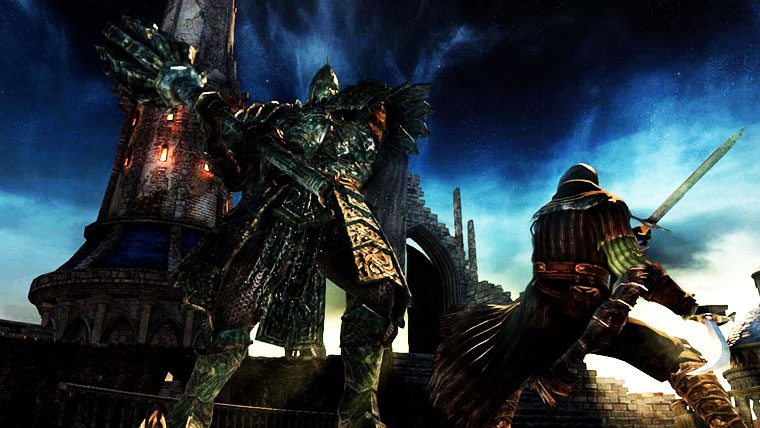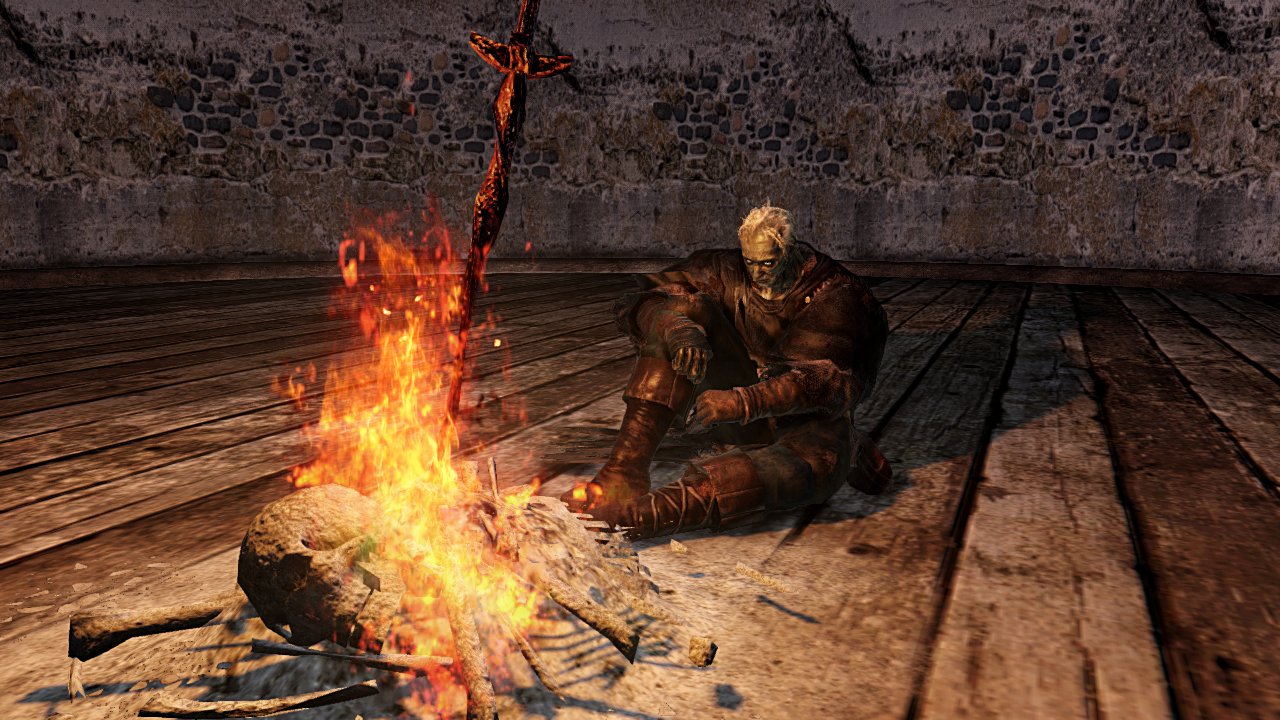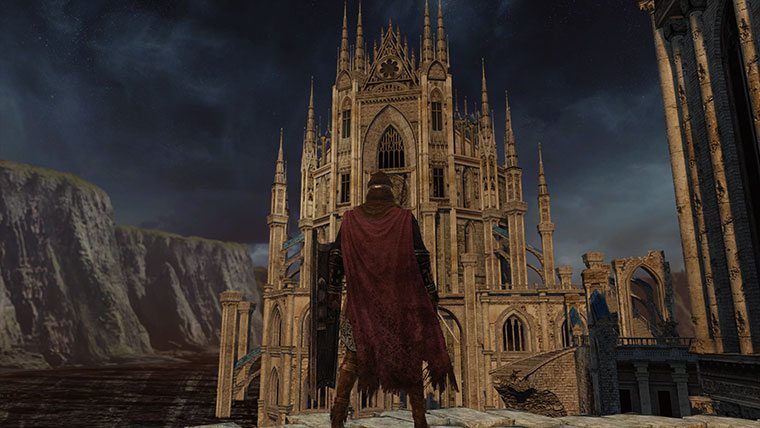The Souls series is an anomaly. It goes against just about everything that AAA games are doing these days, and people love it for its unconventional design, cryptic story, insane difficulty, and complex systems not normally found in today’s role playing games. With Dark Souls 2, From Software has gone back to the drawing board in many regards. It’s an easier game due to some core changes made, but even an easier Dark Souls offers more challenge than most games today. The developers have decided that this time around, they’re going to give players more feedback, more direction, and make life a little easier at times…even if just by a small margin.
Playing the original Dark Souls without an FAQ was like walking around completely blind. There was just so much that was never explained by the game itself. Figuring that game out was like figuring out a cryptic puzzle, but once you did, it was a lot of fun to play. It featured a ton of bosses, interesting levels, loot to collect, and a complex leveling system for both the player and items. It’s also completely plausible that a lot of players never made it into the meat of the game. It was completely up to the player, and the online communities that forged a path, shedding light on the mysterious aspects of the game.

The sequel has retained much of its difficulty, just not all of it
Dark Souls 2 is still a complex, and at times, confusing game. This sequel has retained much of its difficulty — just not all the complexity and difficulty of its predecessor. This is especially true for veterans of the series. Dark Souls 2 will feel like a cake walk in comparison, for a number of reasons.
If you’re new to the series, Dark Souls 2 is not a bad place to start. It’s arguably the best looking, best playing game of the bunch. It’s an adventure role playing game, that offers very little by way of story. What it does let you in on is that you looking for a cure for your curse. That cure is souls. The souls of the biggest and baddest monsters of Drangleic — how you get there, is up to you. You’ll be afforded a completely customizable character, with aesthetic options, and class settings. Each character type plays completely different from one another, and they have different attributes to start out with. As you progress through the game, the souls you collect are used to upgrade your character’s stats and outfit them with bigger and better gear. A heavy loot mechanic has you scouring for hidden items throughout the world, and rummaging through slain corpses for enemy drops. How far you progress in Dark Souls 2 is completely tied to how powerful and equipped your character is, and how good you are at using them in battle. The core gameplay of Dark Souls 2 is battling enemies, collecting their souls, and pressing forward, hoping you don’t lose all you’ve collected before redeeming them for new gear or character attributes.
That doesn’t sound too terribly different than anything else out there. Though, From Software’s strengths in the Souls series has been with such a wide variety of enemy types, bosses, environments, and difficulty. The constant lure of pressing forward for new loot or more souls, Dark Souls 2 is a game that kills you over and over. It’s filled with heart wrenching loss of potentially many hours of play for getting too greedy, and the satisfaction of finally beating that illusive boss or completing an area.

Dark Souls 2 has many complex parts. Some of them not as complex as they once were. The Bonfire mechanic functions as a checkpoint system. These Bonfires are strewn throughout the world, and now function as a fast travel system as well, allowing to quickly head back to the game’s central hub for leveling. The caveat is, that enemies respawn when you visit a Bonfire. The measuring stick in Dark Souls 2 is reaching new Bonfire locations deeper into the world. Traditionally, the bonfire mechanic has given players a sense of meaningful progression. You can literally play Dark Souls 2 for tens of hours and make zero progress whatsoever if you don’t reach the next bonfire. Reaching that illusive next bonfire is a large part of the Dark Souls 2 experience, but there’s been a significant change to the way they work. The original Dark Souls had respawned all enemies in perpetuity, every time you rest at a bonfire. This is not the case anymore. The game doesn’t make you make the difficult decisions you once had to make. You’ll find that now, enemies will slowly be removed from an area, if you keep fighting them. Once densely populated and difficult areas will be ghost towns if you play them enough. This cuts back on farming opportunities for soul grinders, but it also turns down the difficulty quite a bit.
To compensate, From Soft has tweaked the dead and undead forms mechanic. Similar, but very different from the original game, you only get one human life in Dark Souls 2. When you die, you turn undead. When in the undead form, every time you die going forward, your total health will deplete. The maximum amount of health you can start out with will continually plunge, unless you use a specific item — Human Effigy. Human Effigy will allow you to return you to human form, but only for one life. It’s a vicious cycle. It is a form of punishment for dying, that should make the game harder. But it doesn’t, not really. There’s an item that you can find very early on that removes much of this penalty, but even that isn’t the real culprit. It’s easy to see what From Software had in mind by changing this mechanic of the game, but fast travel, the removal of enemies from an area over time, and the ability to simply run past some enemies negates a lot of the difficulty that having less health should provide.
Dark Souls 2 feels like a more conventional, approachable game
These more intricate details and system changes will be more noticeable for those who played Dark Souls or Demon’s Souls. First timers aren’t likely going to be taken aback by the changes. In fact, Dark Souls 2 feels more conventional, and newcomers to the series are welcomed with a better, more approachable game. That’s not to say that Dark Souls 2 won’t offer its share of difficulty regardless of your level of experience with the series.

Dark Souls 2 can be as difficult or easy as you’d like it to be. The many bosses of the game can be fought by your lonesome, or with online partners to make them a little easier. Purists will likely want to tackle what the game has to offer on solo before playing cooperatively, but the built-in assistance of being able to summon other players into your world can make even the hardest bosses of the game extremely easy. But again, summoning players requires that your character be in human form, which requires human effigy to perform. So there’s this constant game within the game that has you balancing and making decisions on when, or when is not the right time to use this limited resource. Littered throughout the campaign are also invasion scenarios. These spice things up in that it’s time for player vs player action. Well, not exactly player vs. player. You’ll be fighting against a human player, as well as all of the computer controlled enemies that may be in an invasion area. It’s all tied to an expanded Covenants system. Players can join Covenants and a protect different parts of the single player world, when other online players are trying to progress. It’s an interesting take on the existing Dark Souls mechanics.
While we’ve touched on much of what many would consider the minutiae of the game, what will hook you regardless is the combat system and beautiful world that From Software has created, yet again. For Dark Souls faithful, the combat system is entirely familiar, with some exceptions made for new character classes. Dark Souls 2 can be played in a number of different ways, and it’ll depend on the way that you build your character. Do you want a hulking armored warrior that dons a heavy armor, and massive weapons and shields? You can tank your way through Dark Souls 2 in its entirety. Or you can take on the role of the more crafty and agile swordsman with dual-wielding capabilities. Combat is still extremely satisfying in Dark Souls 2, and rewards players who are able to learn enemy patterns, and exploit them. These enemy patterns vary wildly, and each and every encounter in the game feels like a dangerous one. This carries forward into the many, many boss battles of Dark Souls 2. Boss fights in Dark Souls 2 are frequent, and no less memorable because of it. There’s a mixture of old and new, if you’ve played previous games you’ll run into some familiar encounters with said baddies, which are no less challenging than the first time you’ve played them. Though as mentioned above, boss fights do come with a easy button. If you’ve got the effigy to spare, they can almost always be beaten on the first try when given the ability to summon either human or AI controlled fighters into the mix.

Dark Souls 2 on PC is clearly the best version of the game
Having had the opportunity to play Dark Souls 2 on both the consoles and PC, the definitive version of the game will be played on the latter… eventually. But even out of the gate, Dark Souls 2 is a better all around experience. Loading times are shorter, resolution and frame rates are better, and the game just feels much smoother overall. While that’s expected when comparing it to a console version for devices that have been around nearly a decade, the PC version isn’t a generational leap by any means. At some point, From Software was experimenting with a new lighting system for the game. One that could have changed the dynamic of the game entirely, but ultimately was scrapped due to technical limitations. It was said to allow players to make difficult decisions when it came to off hand items, like carrying a torch instead of a sheild for greater visibility. This dynamic lighting made Dark Souls 2 a prettier game if early screenshots were any indication. The PC version of the game doesn’t include this dynamic lighting feature, and it’s a shame that the Xbox 360 and PlayStation 3 held the game back so considerably. Dark Souls 2 is still a pretty good looking game on PC, but this is most attributable to the art design and direction, rather than cutting edge lighting engines or other graphical trickery. Where the PC port of the original Dark Souls had many, many issues. The recent steam launch of the game seems to have far less problems, and the problems that have sprouted up seem minor in comparison. However, we did experience some issues with controller sensitivity on the PC, issues that were intermittent and hard to root out a cause. Keyboard and mouse controls are somewhat better than their predecessor, but Dark Souls 2 was designed to be played on a controller, and that’s you’re reminded that every step of the way by using Xbox prompts instead of key commands.
Dark Souls 2 is still a rewarding experience for those who see it through to the end, regardless of previous experience with the Souls series. There are differences, however. There’s less room for frustration in Dark Souls 2. There’s never that feeling of an insurmountable wall that made many turn away from the original game. There’s a lower barrier to entry for newcomers, and there’s more than enough of the familiar qualities of the previous games to appease long-time fans. Essentially, Dark Souls 2 is From Software hitting the sweet spot for the series; challenging enough to keep the devout appeased, and approachable enough to engage and expand their audience. Dark Souls 2 still isn’t for the faint of heart, and especially not recommended for those who enjoy their games with ample hand holding.











Published: Apr 24, 2014 09:00 pm